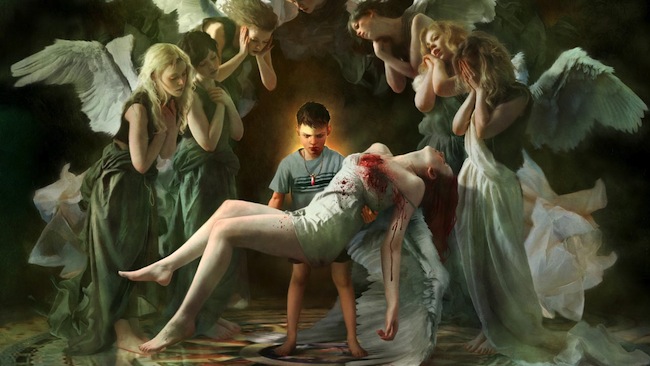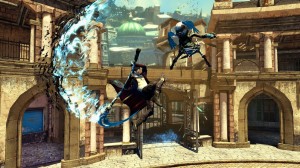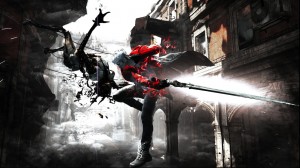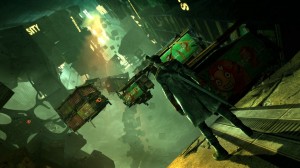
There have always been Angels, there have always been Demons, and they’ve always been at war. It was a simple philosophy, but the smallest things can change everything. Sparda was an influential Demon and right-hand to the powerful Mundus, but he betrayed his mentor when he fell in love with an Angel. Tangled within a taboo love affair, he and Eve raised their twin sons, Dante and Virgil, and it was for many years they lived happily in secret.
However, this serenity was not destined to last as Mundus was vindictive and set out to punish the lovers for their betrayal. It was Eva who chose to sacrifice herself while Sparda took Dante and Vergil away from their home and to safety. He erased most of his sons’ memories to protect them before he was finally captured and condemned to endure eternal punishment and pain for his transgressions.
It has been more than a decade since these events transpired and Mundus’ influence has grown to immeasurable lengths. He sits at the top of Limbo City pulling at the strings of word leaders whilst the Demon controlled media feed the world’s population with propaganda. It would have been perfect if he had not discovered that Sparda had a son secretly living within his own city. This is what he feared most, as a Nephilim, the hybrid of an Angel and Demon was the only thing that could threaten his very existence.
It will quickly become apparent that this is not the Devil May Cry you’ve become accustom too, though this may not come as a surprise thanks to the fanatical controversy the title has attracted over the past two years. However, I’ll stop right here and make it clear that this game does not damage the franchise, and it is not a failure. The “Star Trek” inspired alternate reality reboot might appear cheap, but the game feels fresh and it stands perfectly on its own two feet.
Dante is your typical social outcast, he’s arrogant, selfish and everything else you would expect from a stereotype. However, don’t take this as any indication as to what you can expect from the character. It’s quite clear that in conjunction with his memory loss that Dante is just a product of his environment, and it isn’t long before he learns about his past and the Demon who killed his mother. These revelations force Dante to grow up quickly and with the help of a resistance group known as “The Order”, he sets out on a mission to destroy Mundus.
For everything that changes, there is still a lot that remains the same. The game will play out through chapters, following a standard structure of cutscene-gameplay-scoreboard. However, by comparison to the other games in the series, you can expect a little more narrative to be explored during the gameplay segments. This structure has always suited the franchise well and does not feel too outdated in this latest iteration.
At the completion of a chapter, you will be scored on how well you played, which will then be compounded to unlock additional upgrades. The player is then given the option purchase items, upgrade their abilities or continue on with the story. This is nothing new of course, but it is worth mentioning that chapters can sometimes end in inconclusive places. This invites a convenient break for the player, but it ultimately ends up hurts the pacing of the game at times.

Other franchise staples such as colored orbs, collectable items and hidden levels all make an appearance and work in a similar fashion. There are also many difficulty settings to tackle, challenges to beat and collectables to unlock. It is clear the designers did their best to adhere to what makes Devil May Cry successful, but one thing fans will be disappointed to learn about is the lack of puzzles. They still exist in the game, sort of. They’re just more subtle and will often be tied to the exploration of the environment or in the way you defeat a particular enemy.
This is not an experience that will revolutionise the way we play action games. It is successful bringing the franchise up to speed with what’s currently out there, but like with any reboot, there has to be a line that is just too risky to cross right away. The game admittedly feels more open, which allows players to pursue optional exploration, but this is still an experience that is ultimately linear. There will generally only be one path that will allow the player to progress, but it oddly doesn’t feel restricting and it is with great relief that the tedious hours of backtracking through the same environments are long gone.
It may well be that the core aspects that make a fantastic Devil May Cry game are tied to the gameplay, and this is one area that I believe Ninja Theory nailed. It successfully takes the diverse and over the top combat of the previous games and evolves it in a way that makes sense. Sure it doesn’t run at 60 frames per second, but It still feels natural and fits in well with the game world.
As you progress through the game, there are many weapons, combos and abilities that you will unlock. The controls make it very simple to access your entire arsenal, and you will often be faced with enemies that require different weapons and tactics to defeat. There are no longer awkward camera angles that restrict your perspective, and it is fantastic to see a meaningful evolution of the grapple.
DmC is a well balanced game, and it doesn’t ever feel like you’re platforming or fighting for too long. The grapple is applied in an effective manner, with the blue mode being used to pull you towards something, and the red mode doing the opposite and pulling it towards you. The gameplay is nearly always fluent, and it is only during some boss fights that things might feel unbalanced and a little awkward. These battles are at the least creative, but are often too easy and don’t fit well with the general formula of the game.
Ultimately it was the change in art direction that sparked a phenomenal amount of fan controversy leading up to the games release. Yes, Dante does have a different haircut, but it all feels quite appropriate for the world they’ve created. The visual style of DmC is very different to what we’ve come to expect from the series, but I also need to make clear that it’s equally as fantastic, if not more so.
The Unreal Engine is showing it’s age, and that’s at no major fault of the developer, but I often found myself appreciating the design of the world and the Demons that inhabit it. It still has it’s own unique take on a gothic world, but it’s colorful, creative and fantastic to explore. There were also some moments in the game that must be commended for their visual uniqueness.
The sound design of the game is well presented, with commendable performances from all the leading cast and it’s worth noting that the writers did a fantastic job of avoiding the awfully cheesy dialog of the previous entires. The music choice suits the attitude of the main character, and whilst dubstep seems to be the in-thing for games this past couple of months, it does well to feel appropriate for the experience.
Devil May Cry had always been about a bad-ass Demon hunter named Dante who was out to get revenge for the murder of his family. This is no different, and whilst some of the particulars have been changed or omitted, it feels completely appropriate in this “alternative” universe. There are still a few cliches that the story battles with, but it ultimately has a greater success at delivering a narrative that doesn’t just filter through in a cut-scene at the beginning of each chapter.
The reboot also successfully introduces many fascinating elements into the lore of DmC, the realm of Limbo being one that worked particularly well. It’s not an incredibly deep story outside of the initial premise, but it has sincere moments and does exceptionally well to develop a character that I believe a lot of people were expecting to hate, and evolve him into a relatable and decent guy. If there were any aspect of the game which surprised me the most, this would be it.
DmC: Devil May Cry does well to establish itself as a unique and successful entry into the series. It isn’t perfect, and there remains plenty of room for improvement, but it still feels like a Devil May Cry game, and a good one at that. I think it’s too easy to forget how easily a brand can be damaged when moving from a Japanese to a Western developer (I’m looking at you, Silent Hill), and in particular I found the artistic vision to be surprisingly successful. There is not an aspect of the game that makes it feel like a poor imitation with a bad haircut, and I think Ninja Theory should be commended for a fantastic effort.

















